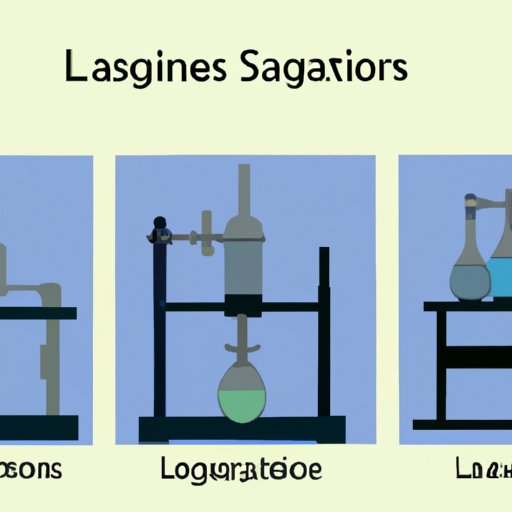
Overview of Apparatus in Science: Definition and Uses
Apparatus is any device or tool used in scientific experiments and laboratory work. It can range from simple tools such as beakers and test tubes to more complex pieces of equipment such as microscopes and Bunsen burners. Apparatus plays an important role in the scientific process, allowing researchers to conduct experiments, collect data, and analyze results.
Definition of Apparatus in Science
The Oxford English Dictionary defines apparatus as “a set of instruments, machinery, tools, materials, etc., used for a particular purpose.” In the context of science, apparatus refers to any device, tool, or instrument used to measure, manipulate, or observe something in a scientific experiment or laboratory work.
Common Uses of Apparatus in Scientific Experiments
Apparatus is used in a variety of ways in scientific experiments, including measuring, manipulating, observing, and recording data. For example, a microscope can be used to observe and record microscopic organisms, while a Bunsen burner can be used to heat substances. Test tubes and beakers are used to mix and measure chemicals, while thermometers are used to measure temperature. Apparatus is also used to create controlled environments in which experiments can be conducted safely and accurately.
Exploring Different Types of Apparatus Used in Scientific Experiments
There are many different types of apparatus used in scientific experiments. Here are some of the most common:
Microscopes
A microscope is a device used to magnify small objects so they can be seen more clearly. It consists of an eyepiece, an objective lens, and a light source. Microscopes are used to observe and study cells, tissues, and other small particles.
Test Tubes
Test tubes are cylindrical vessels used to contain and mix liquids and gases. They are typically made of glass or plastic and come in various sizes.
Beakers
Beakers are wide-mouthed containers used to hold and mix liquids. They come in various sizes and shapes and are typically made of glass or plastic.
Bunsen Burners
A Bunsen burner is a gas-fuelled device used to heat substances. It consists of a gas valve, a tube, and a flame adjuster. Bunsen burners are commonly used in chemical laboratories to heat test tubes and beakers.
Other Commonly Used Apparatuses
In addition to the aforementioned apparatuses, there are many other types of apparatus used in scientific experiments. These include balances, pipettes, thermometers, forceps, flasks, centrifuges, and syringes.
The Role of Apparatus in Laboratory Work
Apparatus plays an important role in laboratory work. Researchers must prepare and assemble apparatus before conducting experiments, and they must test and troubleshoot apparatus to ensure accuracy and safety. Properly preparing and assembling apparatus is essential for successful experimentation.
Preparing Apparatus for Use
Before using apparatus in experiments, researchers must make sure it is clean and in good working condition. This includes checking for cracks, breaks, or other damage that could affect the accuracy of the results. Researchers must also check for proper calibration and make any necessary adjustments.
Assembling Apparatus
Once the apparatus is prepared, it must be assembled correctly. This includes connecting all parts of the apparatus, such as tubing, valves, and sensors, in order for it to function properly. Improper assembly of apparatus can lead to inaccurate results.
Testing and Troubleshooting Apparatus
After the apparatus is assembled, it must be tested and troubleshot. This involves running tests to make sure all parts of the apparatus are functioning properly and making any necessary adjustments or repairs. This step is essential for ensuring accurate results.

The Benefits and Drawbacks of Using Apparatus in the Scientific Process
Apparatus can be both beneficial and detrimental to the scientific process. Here are some of the advantages and disadvantages of using apparatus in experiments.
Advantages of Using Apparatus
Using apparatus in experiments has many advantages. It allows researchers to accurately measure, manipulate, and observe substances. It also helps to create a safe and controlled environment in which experiments can be conducted. Additionally, apparatus can help researchers save time and resources by eliminating the need for manual labor.
Disadvantages of Using Apparatus
While apparatus can be beneficial, it can also be detrimental to the scientific process. Poorly prepared and assembled apparatus can lead to inaccurate results, and testing and troubleshooting apparatus can be time consuming. Additionally, some apparatus can be expensive and difficult to use.

Best Practices for Properly Setting Up and Using Apparatus in Scientific Research
To ensure accurate results, researchers should follow certain best practices when setting up and using apparatus in scientific experiments. Here are some tips for properly setting up and using apparatus:
Tips for Setting Up Apparatus
When setting up apparatus, researchers should always read the instructions carefully and make sure all parts are connected correctly. They should also check for any damage or defects and make sure all parts are clean and in good working condition.
Safety Precautions When Working with Apparatus
Researchers should also take safety precautions when working with apparatus. This includes wearing protective gear such as goggles, gloves, and lab coats, and following all safety protocols. Additionally, researchers should always keep the area around the apparatus clean and free of clutter.
Guidelines for Properly Cleaning and Storing Apparatus
Finally, researchers should make sure to properly clean and store apparatus after each use. This includes wiping down surfaces, disconnecting all parts, and properly storing the apparatus in a secure location. Following these guidelines will help ensure accurate results and extend the life of the apparatus.
Apparatus plays an important role in scientific experiments and laboratory work. By understanding the definition of apparatus, common uses, different types, benefits and drawbacks, and best practices for properly setting up and using apparatus, researchers can ensure accurate results and a safe working environment.
(Note: Is this article not meeting your expectations? Do you have knowledge or insights to share? Unlock new opportunities and expand your reach by joining our authors team. Click Registration to join us and share your expertise with our readers.)
